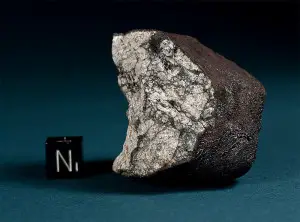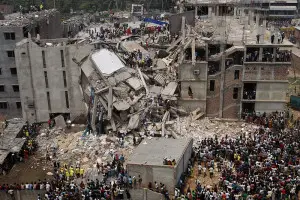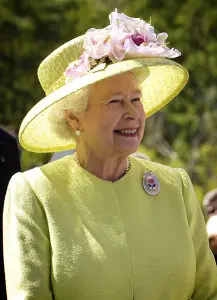World news of the first half of 2013 mostly focused around the political conflicts and wars, with American involvement. Important among them were the Syrian conflict and the firm stand of North Korea. Change of papacy is also a distinguishing feature of the first half of 2013. Natural disasters in the form of earthquakes, landslides, torrential rains and river floods have also been notable features of this period. In addition to the natural disasters, manmade works too have caused immense disasters. Famous stories of this period include some interesting scientific discoveries. Genetic engineering has helped man resolve some old unsolved secrets, and scientists have been able to reconstruct whole the skull of the earliest human beings, starting from DNA taken from only a toe. Growth of some bryophytes, left frozen under glaciers for more than 400 years, has been revived in a research lab.
1. Stade Félix Houphouët-Boigny, stampede – January 1, 2013

Formerly known as Stade Andre Geo, the renovated stadium in Abidjan, Ivory Coast, was renamed after the president Felix Houphouët-Boigny. It was built in 1964 to organize the Games of Abidjan. It had also hosted Amnesty International’s Human Rights Now! Benefit Concert in the past. On January 1, 2013, between 1 and 4 a.m., a homebound mob ran into another mob moving in the opposite direction. People were returning to their homes following the fireworks play in connection with the New Year’s Eve fireworks display. In the deadly stampede, 61 people, including 26 children, were killed and more than 200 were injured. The president Felix Houphouët-Boigny declared three days national mourning. The government extended condolences to the families of the deceased and promised thorough probe into the cause of the stampede. A senior officer commented that ‘people were walked over and suffocated by the crowd.’
2. Hillary Clinton says goodbye to state department – February 1, 2013 (Friday)

The 65-year-old, most beautiful former first lady, Hillary Clinton stepped down as United States Secretary of State, after four years of her dedicated service. During her tenure, she had visited 112 countries and traveled about a million air miles. She was succeeded by the Massachusetts senator John Kerry. She tendered her resignation to President Obama, who was her arch rival in the 2008 Democratic presidential nomination. She wrote in her letter that she was more convinced than ever that of America’s strength as a global leader and its potential to be a force for good. Addressing to her staff, she said, ‘I am so grateful that we’ve had a chance to contribute in each of our ways to making our country and our world stronger, safer, fairer and better.’
3. Pope Benedict XVI announces his resignation – February 11, 2013 (Monday)

Pope Benedict XVI resigned on February 28, 2013 at 8 p.m. He was to first pope to resign after the resignation of Gregory XII in 1415. Customarily, the modern popes have held their office from their election until death. He announced his resignation in Latin at the Apostolic Palace in the Sala del Concistoro, on the World Day of the Sick. He told the audience that he had made ‘a decision of great importance for the life of the church.’ He also said that he would continue to serve the church ‘through a life dedicated to prayer.’ The pope assigned the reason of his resignation to his advancing age and declining health. He resigned at the age of 85 years.
4. Chelyabinsk meteor, February 15, 2013 (Friday)

On February 15, 2013 a 10-ton meteor entered the Earth’s atmosphere at a speed of 41,000 miles per hour, which is almost 60 times the speed of sound. The meteor broke up in the vicinity of the city of Chelyabinsk, Russia, injuring 1,200 people by the shattering of the windows, caused by the shockwaves and debris arising from the impact. It was considered to be the most destructive meteor that hit the earth after 1908. The asteroid became a luminous superbolide meteor, later to be known as the Chelyabinsk meteor.
5. North Korea conducts its third underground nuclear test – February 12, 2013

North Korean state media announced on February 12, 2013 that the country had conducted an underground nuclear test, the third in seven years. Its magnitude was initially recorded as 4.9 but later on raised to 5.1 as observed by The China Earthquake Networks Center and the United States Geological Survey, Comprehensive Nuclear-Test-Ban Treaty Organization Preparatory Commission. Whereas the test has prompted international condemnation, the Japanese and Chinese agencies have failed to detect any radiation and it is also considered that the test might be a non-nuclear mimicry. South Korea had raised its military alert status, whereas Japan had summoned an emergency UN meeting.
6. Cardinal Jorge Mario Bergoglio is elected the 266th pope – March 13, 2013

Following the resignation of Pope Benedict XVI on February 28, 2013, the papal conclave was convened to elect his successor. One hundred fifteen cardinal electors gathered and set March 12, 2013 as the beginning of the conclave. Following the fifth ballot, white smoke started emanating from the Sistine Chapel chimney on March 13, 2013 at 19:06 local time. Soon after the appearance of the smoke, bells started ringing to signify the election of the new pope. The conclave had elected Jorge Mario Bergoglio, SJ, an Argentine cardinal and archbishop of Buenos Aires, as the new pope, who selected the papal name of Francis.
7. An eight-story commercial building collapses in Bangladesh ‘ April 24, 2013

On April 24, 2013, an eight-story commercial building, Rana Plaza in Savar Upazila near Dhaka, the capital of Bangladesh, collapsed, leaving 1,129 dead and more than 2,500 injured. It is considered the deadliest non-terrorist building collapse in modern times. Cracks appeared in the building a day before the collapse and whereas the ground floor occupants of the banks and other shops had been evacuated, the garment workers were forced to resume work. Immediately after the collapse, the UN offered rescue assistance, but was denied by Dhaka. The building was not meant for the installation and operation of heavy machinery. Its weight and vibration were the root causes of the accident. Seventeen days after the collapse, a woman was recovered alive and intact from the debris.
8. Death of Margaret Thatcher – April 8, 2013

The longest serving female Prime Minister of the United Kingdom died of stroke in London on April 8, 2013 at the age of 87 years. She had been the Prime Minister of the United Kingdom from 1979 to 1990. She died at The Ritz Hotel and her spokesman confirmed her death to the Press Association, who issued the first report to newsroom at 12:47 BST, April 8, 2013. The Union Jack was flown at half-mast at Buckingham Palace, Downing Street, Parliament and other government buildings. Queen Elizabeth II and her husband The Duke of Edinburgh led the mourners at her funeral.
9. Queen Elizabeth II opens broadcasting House – June 7, 2013 (Friday)

On June 7, 2013 Queen Elizabeth visited the BBC broadcaster’s London headquarters after it had been revamped at the cost of £1bn. While the BBC News presenters Julian Worricker and Sophie Long addressed viewers from the glass walled studio, the queen appeared to the most pleasant surprise of the presenters and viewers. The Queen was clad in turquoise coat and hat. While officially opening the building, referring to a previous visit 60 years back, she said, ‘I was struck then, as I am now, by the sheer pace of change which has transformed your industry over the past 60 years; years during which broadcasting has enriched our lives in so many ways.”
10. Scientists build a robotic ant colony – March 29, 2013

On March 29, 2013 scientists at the French National Center for Scientific Research and the New Jersey Institute of Technology, developed a robotic ant colony. Alice, a tiny, wheeled cubical robot was programmed to follow light trails, as the real ants followed the pheromone trails to find the shortest possible root. In spite of ordinary visual and brain power, the ants have the remarkable capability of skipping obstacles to find the shortest possible route for food, even in the case of two apparently similar routes. The experiments were 75% successful. Simple ant behaviors were studied and the findings of research were incorporated in developing the robotic ant army, capable of finding the shortest routes in a maze and similar complex systems.
Conclusion
The first half of 2013 has been a turbulent period of wars and conflicts. New stories had been regularly unfolded through famous and important world news. Diseases are constantly at rise and so are their fast-developing treatments. Ever-increasing human misery, at the hands of human beings, constitutes the basis of the world news, in one or the other form. Mark Twain said, ‘Apparently there is nothing that cannot happen today.’










Leave a Reply